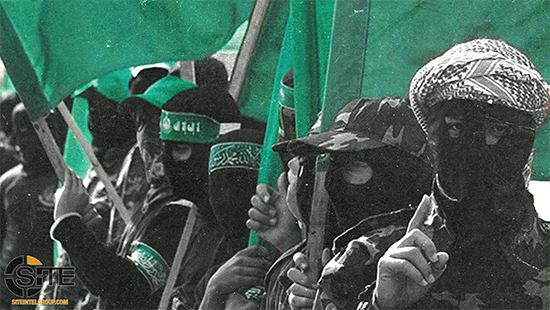Rita Katz’ Recent Quotes on the Israel-Hamas War: Hamas’ Objectives, Twitter, and Rampant Disinformation
By Rita Katz | Published 11.14.2023

Amid the Israel-Hamas war, SITE Executive Director Rita Katz has provided ongoing insights to several news outlets on why Hamas attacked, the roles of platforms like Telegram and X (formerly Twitter), and the rapidly escalating dangers of disinformation regarding the conflict. Below are selected quotes from Katz in articles by The Washington Post, The Times of London, Wired, and Al Arabiya.
You can also read Katz’ own recent articles on the al-Qaeda-aligned agenda that drove Hamas’ attack and how other extremist factions seek to mimic its perceived success.
Why Did Hamas Attack?
Washington Post: Hamas Envisioned Deeper Attacks, Aiming to Provoke an Israeli War
Hamas’s pronouncements welcoming a broader conflict evoke statements by al-Qaeda leaders in the aftermath of the Sept. 11, 2001, attacks, noted Rita Katz, executive director of the SITE Intelligence Group, a private organization that studies the ideology and online communications of extremist groups. Al-Qaeda leader Osama bin Laden expected a furious American response after the attacks on New York and Washington, Katz said, and he welcomed what he believed would be a violent, global confrontation between the Muslim world and the West, with Islam ultimately prevailing.
“Hamas knew Israel would strike back hard. That was the point,” Katz said. “To Hamas, Palestinian suffering is a critical component in bringing about the instability and global outrage it seeks to exploit.”
Even if its current leadership is effectively destroyed, she said, Hamas and its followers will continue to regard Oct. 7 as a victory. That’s partly because the group unquestionably succeeded in focusing the world’s attention on the Palestinian conflict, she said.
“It’s the first time I can remember that Hamas has become so prominent on a global scale,” Katz said. “So many people have already forgotten Oct. 7 because Hamas immediately changed the discussion. It put the focus on Israel, not themselves. And that’s exactly what they wanted.”
Times of London: Hamas-Israel War May Recruit for the Next Global Wave of Jihadism
Since Hamas carried out its murderous attacks on October 7, its tactics have been frequently compared to Isis. But seasoned analysts have begun to ask if Hamas was actually following the strategy outlined by Azzam and al-Qaeda.
Rita Katz of Site Intelligence, who has tracked jihadist movements for decades, wrote this week that “Hamas carried out its October 7 terrorist attack for the same reason that al-Qaeda carried out 9/11 and that Isis carried out many of its own brutal attacks: to reap massive casualties, provoke drastic responses and rally supporters from around the world”.
Katz added: “The attack had Sunni and Shi’ite extremists alike praising Hamas and pondering how they could follow its example. These reactions play into the goals of groups like Hamas and al-Qaeda, which is to provoke potential recruits to join militant jihad, bring forth the travel of fighters to the affected regions, instigate perpetual war, and open flood gates for years of conflict.”
Sowing Disinformation
Al Arabiya: Fact or Fiction? The Damage of Misinformation, Disinformation in the Israel-Hamas War
“The intensity surrounding this conflict makes this disinformation all the more dangerous. Given all the protests and even deadly attacks we’ve seen across the globe in the last month, it’s not hard to imagine a fake image or video going viral and inspiring an attack.”
“Whatever productive discourse or democratized journalism Elon [Musk] envisioned for X has not played out, and this Israel-Hamas war content is proof.”
“During crises like the COVID-19 pandemic, Twitter was far more aggressive in combatting this content, pushing the fringe conspiracists and trolls onto Telegram and ‘alternative’ social media platforms. Even with the Russia-Ukraine war, most of the globally aimed disinformation action is happening on Telegram, with X being a secondary venue to further disseminate it,” she said.
“Even respected outlets like the New York Times were forced to walk back their reporting about the Al-Ahli Arab Hospital blast, admitting that they took too seriously the dishonest claims of Hamas. This, though, begs the question: Why would reporters give Hamas any more credibility than they would ISIS?”
“The platform’s laxed censorship policies and algorithms – combined with the divisive nature of this conflict – have laid the foundation for the chaos we now see on X. Of course, I understand that honest mistakes in reporting are an inevitability and that liars and trolls are not new to Twitter, but these problems on X have never been so consequential as they are now,” Katz added. >
“Add AI [artificial intelligence] to the equation, and now you’ve arrived at the unprecedented chaos we see playing out: Rapidly produced propaganda posters spammed everywhere, fake images being reported on as legitimate news. Even AI image-detecting programs can’t often settle the authenticity of an image, as seen with a photo of a burned baby,” said Katz, referring to a doctored image shared in the early days of the current conflict.
“Reports of the supposed event were all over Twitter, accompanied by a video of militants exchanging fire. It took hours before denials by both the Palestinian Authority and the group mentioned settled things down. The Internet is the main battleground for extremist communities from ISIS to neo-Nazi accelerationists. Without the Internet – and unmoderated venues thereon –they can’t grow. Watching what is happening with the Israel-Hamas war, I’d say that assessment stands,” Katz further observed.
Times of London: Israel-Gaza War: Social Media Hosts War of Fake News and AI Images
“In my 25 years of tracking extremism and conflicts, I have never seen disinformation reach such viral levels as it has during this war between Israel and Hamas,” Rita Katz, the director of the Site Intelligence Group, said. “Disinformation surrounding the Israel-Hamas war is uniquely dangerous because there are few, if any issues that divide societies as much as this one,” she said. “Across the world, people are demonstrating, spewing hate, and literally killing each other over war in a relatively small portion of the Middle East. No other conflict — be it the Syrian civil war, Ukraine war or others — could do this.”
...
“Twitter [now X] is of course not housing the entirety of disinformation and wartime propaganda”, Katz said. “Hamas’s official outlets are based almost entirely on Telegram, from which it has launched a profound new propaganda campaign.
“Prior to its offensive against Israel, the Telegram channel of Hamas’s military wing was relatively mundane: photos of martyrs, communiqués, news commentary, some videos here and there.
“However, upon the launch of its offensive, the group immediately unleashed a massive, non-stop deluge of skillfully edited combat footage. Hamas designs the videos to go viral by condensing it into short, digestible clips tailored for today’s quick-bite styles of content.”
Telegram as a Propaganda Machine
Times of London: How Hamas uses Telegram to Spread Terror and War Propaganda
Hamas’s content has also morphed since October 7. Rita Katz, executive director of the Site Intelligence Group in Washington, said: “Hamas’s media has changed completely since its barbaric act of terror on Israel. The group is relying on its multiple Telegram venues to mobilize followers all over the world in a similar way that Isis [Islamic State] did.
“As somebody who has been working in counterterrorism for 25 years, it’s impossible to ignore the similarity of Hamas’s latest propaganda to that of Isis, and with constant non-stop media. The style of the short video clips showing hostages and executions, portraying itself simultaneously as kind but also as savage killers — it’s all Isis.”
...
Katz says the attacks have united and inspired the worldwide jihadist community online. “Immediately after Hamas began publishing news of its operation, Sunni and Shiite extremist factions alike began flooding social media platforms with celebratory messages, as did their scholars,” she said. “It is virtually unheard of for Shiite and Sunni extremists to be on the same page about a subject, yet here were all of their online outlets, forwarding, mirroring deluges of updates from Hamas.”
Wired: How Telegram Became a Terrifying Weapon in the Israel-Hamas War
Hamas’ own channels still played the commanding role. Analysts at SITE Intelligence Group, a consultancy which monitors the Qassam Brigades channel, claim that Hamas’ Telegram strategy totally changed on October 7. Whereas before it was somewhat dated, now it was specifically designed for “2023 virality,” SITE says. Livestreams were accompanied by a deluge of short, branded clips that could easily be shared. “I couldn’t believe what Hamas was posting,” says Rita Katz, SITE’s executive director and founder. She believes the group’s strategy was partly inspired by the Islamic State’s playbook.
Katz alleges that Hamas’ social media activity has been effective in cultivating rare support across disparate radical Islamist groups around the world, whether Sunni or Shia. “It’s the first time anything like this has happened,” she claims.
Without Telegram, this would have been impossible, argues Katz. “What you can do on Telegram, you can’t do anywhere else. It allows for quick uploads and sharing, to utilize automated bots, to stay anonymous. No other platform comes close.” Katz points to what she claims is an alleged inconsistency in Telegram’s actions given Durov’s stated refusal to move against Hamas’ channels despite the platform removing other groups
...
Even so, Hamas’ ability to widely share images and videos of its attacks have the potential to inspire further violence, Katz argues. “Unless Telegram immediately takes action,” she says, “this is going to escalate and be a much bigger problem. Because this will lead to more violence around the world.” And for that, Katz claims, Telegram will be in no small part responsible.

Rita Katz
Executive Director & Founder
Rita Katz is the founder and Executive Director of SITE Intelligence Group. She has tracked and analyzed global terrorist networks for decades and is well-recognized as one of the most knowledgeable and reliable experts in the field. She has infiltrated terrorist fronts, testified before Congress in terrorism trials, and briefed officials at the White House and Cabinet.
Ms. Katz has authored two acclaimed books on terrorism, Saints and Soldiers (Columbia University Press, 2022) and Terrorist Hunter (Harper Collins, 2003). To learn more about Rita Katz and SITE Intelligence Group, click here.






